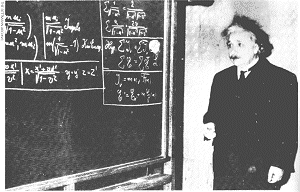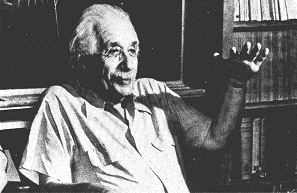
 |
How it works : Einstein,Albert |
EINSTEIN, Albert (1879-1955)
Albert Einstein, the theoretical physicist famous for his theory of RELATIVITY, was born in 1879 at Ulm, Germany, to parents of German-Jewish descent. His early education, at first in Munich and later in Switzerland, did not mark him out as any kind of genius at all. He found the pedantic methods of the German education system totally uninteresting, and he used often to miss lessons in order to indulge his voracious appetite for reading. At 17, he entered the Swiss Federal Polytechnic in Zurich after rapid cramming of a subject he had somewhat neglected-mathematics. The more liberal and easygoing atmosphere of Switzerland was much more in keeping with his own reflective ways, and in 1901 after graduating, he took out Swiss citizenship. Years later, in the winter of 1932-3, while Einstein was on a fortuitous visit to the California Institute of Technology, Hitler came to power in Europe, and Einstein decided to stay on in the United States, becoming an American citizen in 1940.
| Below: Professor Albert Einstein, photographed in December 1934, delivering a lecture at the American Association for the Advancement of Science at the Carnegie Institute of Technology. |
 |
He had entered the Polytechnic with the idea of becoming a teacher but had difficulty in finding a post and ended up in the patent office in Berne. In 1905 he received his doctorate in physics from the University of Zurich. That year saw the publication of three of his papers, any one of which would have earned him a doctorate. Unfortunately, many of his ideas were only intelligible to a small minority of physicists and recognition did not come immediately.
In each of these papers, however, Einstein had managed to combine the principle of sound empirical science-that any explanation must make as few unproven assumptions as possible-with an acute insight of new ideas. One of these papers was on the Special Theory of relativity, which was to appear in its final form in 1915 as his General Theory of relativity. It literally overturned the then accepted basis of physics. Experiments measuring the speed of light had shown its speed to be exactly the same whether the source was moving away from or towards the observer. This was, however, a contradiction of Newtonian mechanics.
This paradox was resolved by Einstein's Special Theory. It involved, however, a new interpretation of mechanics, which resulted in the essential equivalence of mass and energy. Matter, said Einstein, was a form of energy, and energy a form of matter, with their interrelationship expressed by the famous equation E = mc2 where E= energy, m = mass, and c2= the square of the speed of light. When a minuscule amount of mass is annihilated, it is replaced by an immense amount of energy: this is the principle behind atomic energy.
The other papers published in 1905 dealt with his explanations of the photoelectric effect, for which he was awarded the Nobel Prize in 1922, and of Brownian motion. The former was a turning point in modern physics. It not only provided the first clear and qualitative account of the ionization of metals by a beam of light, but it also showed that light came in discrete 'packets', which he called photons. Light was therefore shown to be quantized, just as matter was known to be. Five years previously Niels Bohr had shown a similar quantizing of the energy of the electrons in the atom, and so the stage was now set for the development of the QUANTUM THEORY. Relativity and the quantum theory are two of the most important contributions to twentieth-century physics.
| Below: Albert Einstein holding an informal seminar at the Institute of Advanced Learning. |
 |
Brownian motion, the small zigzagging movements executed by dust particles immersed in a fluid, had baffled scientists since its discovery by the Scottish botanist Robert Brown in the nineteenth century. Einstein's paper explained it in terms of the millions of collisions that take place between the molecules of the fluid and immersed microscopic particles. This also had important ramifications for the advancement of physics, for it was the first occasion that the atomic theory was shown capable of producing explanations of observed phenomena.
Einstein spent the following years working through his conceptions of space and time, supporting himself and his family in a number of teaching posts in various European universities. After teaching at the University of Berne he moved, in 1909, to the University of Zurich and in 1910 to the German University of Prague, returning to the Swiss Polytechnic in Zurich in 1912. Finally in 1913 he settled in Berlin to become a professor at the University of Berlin and a member of the research institute, the Royal Prussian Academy of Sciences, as well as a director of the prestigious Kaiser Wilhelm Institute. While there, his General Theory of relativity was published. This work, of enormous intellectual and philosophical elegance, developed the concepts he had outlined in the Special Theory into a new interpretation of the Universe. In it, the laws of physics were reduced to those of the geometry of a space-time continuum. It related gravitation with electromagnetics, two fundamental forces of the Universe that had been hitherto treated as distinct entities. The first proof of his theory came shortly afterwards, when it was observed during an eclipse of the Sun that the light from distant stars is bent as it passes close to the gravitational pull of the Sun.
In his personal attitudes Einstein reflected the growing realization within the scientific community that the scientist, by virtue of both his intellect and the nature of his discoveries, has a special responsibility towards society. World War I affected him deeply, and made him very conscious of the outside world and the social injustice and folly that abounds there. Yet he was too much of a genius to ever live completely outside the rarefied atmosphere of his own mind. He was notoriously absent-minded, and anecdotes about him are to be found in abundance in his biographies. One day, for example, a student pointed out to him that he had forgotten to put on any socks. Einstein observed that, since he had not noticed it beforehand, socks must be a quite expendable article of clothing. From that day he is supposed never to have worn socks.
In 1921 he visited America to speak on behalf of the Zionist cause, and in 1922 he was appointed to the Intellectual Co operation arm of the League of Nations. When it became known in 1939 that German scientists were working on the FISSION process that would lead to the construction of an A-BOMB, he wrote his now famous letter to President Roosevelt. As a result of this, the Manhattan Project was set up, which resulted in the development of the atomic bomb by the Americans before the Germans. He was deeply involved throughout the war in organizations providing relief for refugees from war-torn Europe. He died at Princeton, New Jersey in 1955.
Perhaps the best epitaph for him is the German proverb he was fond of quoting to express his own convictions about the world, 'God is subtle, but he is not malicious'.
Reproduced from HOW IT WORKS p838